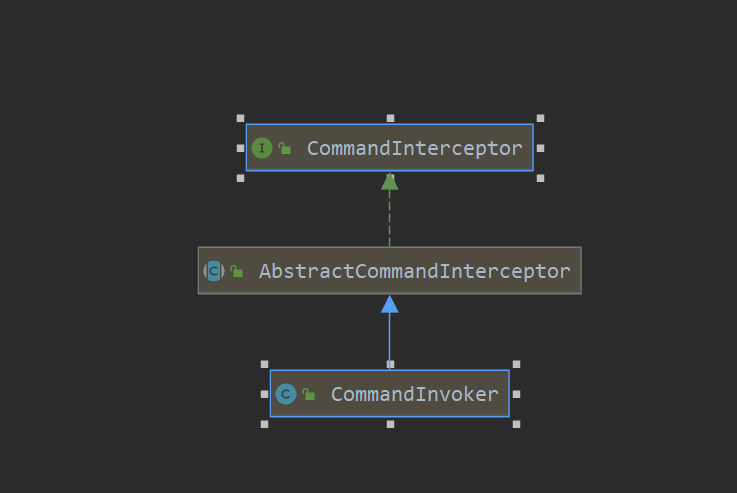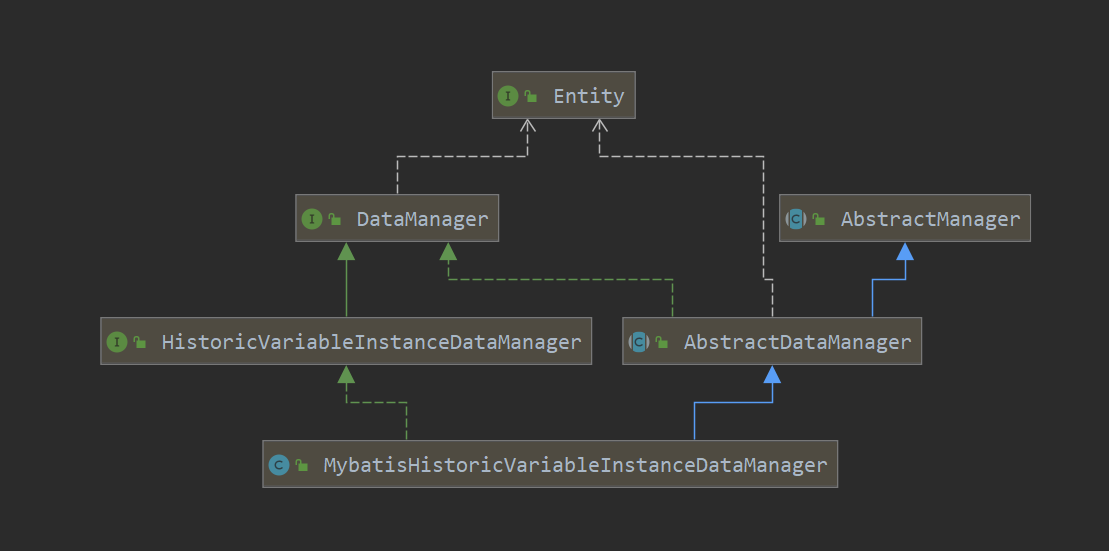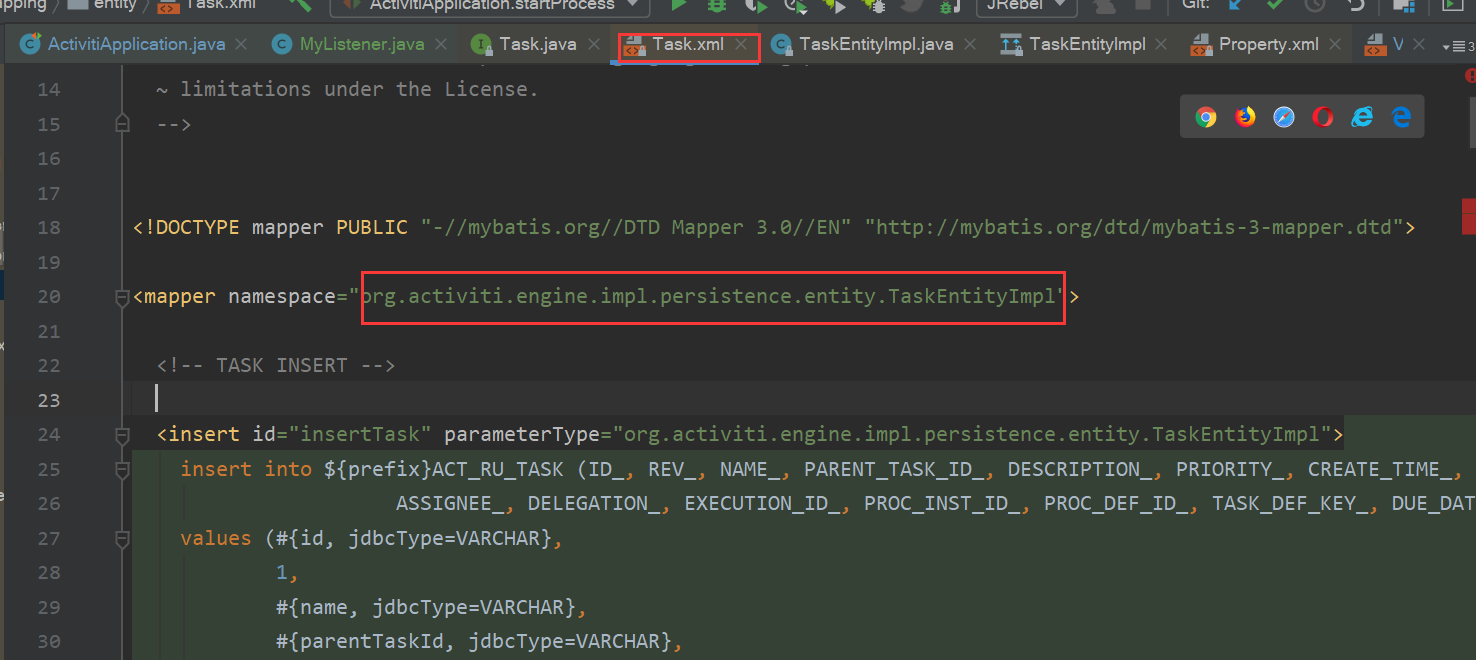01-activiti6基础——引擎如何数据库操作及相关表
官网文档:https://www.activiti.org/userguide/#queryAPI
1. Activit的简单源码解读
activiti的官方文档讲解详细很详细,也很范。按着文档写完了一个简单的demo发现,现实中的大多数问题,还是没法很好的解决。
例如:首先我需要知道的是,activiti的有那些表,及各个表的作用。这个网上有人罗列过,但总是觉得不通透。
所以,我先简单看了一下activiti数据处理的源码。
1.1 流程发布
- RepositoryServiceImpl
进行具体操作的封装,传递Command接口的对应子类,里面封装了具体的操作
public Deployment deploy(DeploymentBuilderImpl deploymentBuilder) {
return commandExecutor.execute(new DeployCmd<Deployment>(deploymentBuilder));
}
- CommandInvoker
commandExecutor.execute() 这个方法的执行本质,是里面的CommandInterceptor执行链式的execute,而实质执行的是传进来的CMD接口类的execute方法。具体如下所示。

public <T> T execute(final CommandConfig config, final Command<T> command) {
final CommandContext commandContext = Context.getCommandContext();
//省略一些代码
commandContext.getAgenda().planOperation(new Runnable() {
@Override
public void run() {
commandContext.setResult(command.execute(commandContext));//这里是关键
}
});
// 省略一些代码。。。。。。。。。。。。
return (T) commandContext.getResult();
}
- DeployCmd(从这里调用DataManager的实现类进行相关数据库操作)
public Deployment execute(CommandContext commandContext) {
// Backwards compatibility with Activiti v5
if (commandContext.getProcessEngineConfiguration().isActiviti5CompatibilityEnabled()
&& deploymentBuilder.getDeploymentProperties() != null
&& deploymentBuilder.getDeploymentProperties().containsKey(DeploymentProperties.DEPLOY_AS_ACTIVITI5_PROCESS_DEFINITION)
&& deploymentBuilder.getDeploymentProperties().get(DeploymentProperties.DEPLOY_AS_ACTIVITI5_PROCESS_DEFINITION).equals(Boolean.TRUE)) {
return deployAsActiviti5ProcessDefinition(commandContext);
}
return executeDeploy(commandContext);
}
- DeploymentEntityManagerImpl
实际数据库操作的是DataManager的实现类,进行数据库操作。
这个我们能看出来是有两个
@Override
public void insert(DeploymentEntity deployment) {
insert(deployment, false);
for (ResourceEntity resource : deployment.getResources().values()) {
resource.setDeploymentId(deployment.getId());
getResourceEntityManager().insert(resource);
}
}
- 对应的xml操作
在mapping目录下可以查找到对应的操作。前面的${prefix}标识数据库,activiti已经帮我们判断好了,不需要我们再传入。
<insert id="insertDeployment" parameterType="org.activiti.engine.impl.persistence.entity.DeploymentEntityImpl">
insert into ${prefix}ACT_RE_DEPLOYMENT(ID_, NAME_, CATEGORY_, KEY_, TENANT_ID_, DEPLOY_TIME_, ENGINE_VERSION_)
values(#{id, jdbcType=VARCHAR}, #{name, jdbcType=VARCHAR}, #{category, jdbcType=VARCHAR}, #{key, jdbcType=VARCHAR}, #{tenantId, jdbcType=VARCHAR}, #{deploymentTime, jdbcType=TIMESTAMP}, #{engineVersion, jdbcType=VARCHAR})
</insert>
<insert id="insertResource" parameterType="org.activiti.engine.impl.persistence.entity.ResourceEntityImpl">
insert into ${prefix}ACT_GE_BYTEARRAY(ID_, REV_, NAME_, BYTES_, DEPLOYMENT_ID_, GENERATED_)
values (#{id, jdbcType=VARCHAR}, 1, #{name, jdbcType=VARCHAR}, #{bytes, jdbcType=${blobType}}, #{deploymentId, jdbcType=VARCHAR}, #{generated, jdbcType=BOOLEAN})
</insert>
1.2 数据查询
- DataManager
数据查询操作本质都是通过DataManger的实现类MybatisDeploymentDataManager进行操作;
@Override
public List<Deployment> executeList(CommandContext commandContext, Page page) {
checkQueryOk();
return commandContext.getDeploymentEntityManager().findDeploymentsByQueryCriteria(this, page);
}
@Override
@SuppressWarnings("unchecked")
public List<Deployment> findDeploymentsByQueryCriteria(DeploymentQueryImpl deploymentQuery, Page page) {
final String query = "selectDeploymentsByQueryCriteria";
return getDbSqlSession().selectList(query, deploymentQuery, page);
}

- 查找xml中对应的sql
<select id="selectDeploymentsByQueryCriteria" parameterType="org.activiti.engine.impl.DeploymentQueryImpl" resultMap="deploymentResultMap">
${limitBefore}
select distinct RES.* ${limitBetween}
<include refid="selectDeploymentsByQueryCriteriaSql"/>
${orderBy}
${limitAfter}
</select>
1.3 任务执行
需要了解任务类型,以及网关相关知识。
- TaskService
taskService.complete(task.getId(), taskVariables);
- AbstractCompleteTaskCmd
protected void executeTaskComplete(CommandContext commandContext, TaskEntity taskEntity, Map<String, Object> variables, boolean localScope) {
// Task complete logic
if (taskEntity.getDelegationState() != null && taskEntity.getDelegationState().equals(DelegationState.PENDING)) {
throw new ActivitiException("A delegated task cannot be completed, but should be resolved instead.");
}
//执行节点监听事件
commandContext.getProcessEngineConfiguration().getListenerNotificationHelper().executeTaskListeners(taskEntity, TaskListener.EVENTNAME_COMPLETE);
if (Authentication.getAuthenticatedUserId() != null && taskEntity.getProcessInstanceId() != null) {
//查找任务select * from ${prefix}ACT_RU_EXECUTION
// where ROOT_PROC_INST_ID_ = (select ROOT_PROC_INST_ID_ from ${prefix}ACT_RU_EXECUTION where ID_ = #{parameter})
ExecutionEntity processInstanceEntity = commandContext.getExecutionEntityManager().findById(taskEntity.getProcessInstanceId());
//任务和identity绑定
commandContext.getIdentityLinkEntityManager().involveUser(processInstanceEntity, Authentication.getAuthenticatedUserId(),IdentityLinkType.PARTICIPANT);
}
ActivitiEventDispatcher eventDispatcher = Context.getProcessEngineConfiguration().getEventDispatcher();
if (eventDispatcher.isEnabled()) {
if (variables != null) {
eventDispatcher.dispatchEvent(ActivitiEventBuilder.createEntityWithVariablesEvent(ActivitiEventType.TASK_COMPLETED, taskEntity, variables, localScope));
} else {
eventDispatcher.dispatchEvent(ActivitiEventBuilder.createEntityEvent(ActivitiEventType.TASK_COMPLETED, taskEntity));
}
}
//删除已有的任务相关数据
commandContext.getTaskEntityManager().deleteTask(taskEntity, null, false, false);
// Continue process (if not a standalone task) 激活下个步骤工作
if (taskEntity.getExecutionId() != null) {
ExecutionEntity executionEntity = commandContext.getExecutionEntityManager().findById(taskEntity.getExecutionId());
Context.getAgenda().planTriggerExecutionOperation(executionEntity);
}
}
1.4 获取类对应表名称
ManagementService
managementService.getTableName()
TableDataManagerImpl
static {
// runtime
entityToTableNameMap.put(TaskEntity.class, "ACT_RU_TASK");
entityToTableNameMap.put(ExecutionEntity.class, "ACT_RU_EXECUTION");
entityToTableNameMap.put(IdentityLinkEntity.class, "ACT_RU_IDENTITYLINK");
entityToTableNameMap.put(VariableInstanceEntity.class, "ACT_RU_VARIABLE");
entityToTableNameMap.put(JobEntity.class, "ACT_RU_JOB");
entityToTableNameMap.put(TimerJobEntity.class, "ACT_RU_TIMER_JOB");
entityToTableNameMap.put(SuspendedJobEntity.class, "ACT_RU_SUSPENDED_JOB");
entityToTableNameMap.put(DeadLetterJobEntity.class, "ACT_RU_DEADLETTER_JOB");
entityToTableNameMap.put(EventSubscriptionEntity.class, "ACT_RU_EVENT_SUBSCR");
entityToTableNameMap.put(CompensateEventSubscriptionEntity.class, "ACT_RU_EVENT_SUBSCR");
entityToTableNameMap.put(MessageEventSubscriptionEntity.class, "ACT_RU_EVENT_SUBSCR");
entityToTableNameMap.put(SignalEventSubscriptionEntity.class, "ACT_RU_EVENT_SUBSCR");
// repository
entityToTableNameMap.put(DeploymentEntity.class, "ACT_RE_DEPLOYMENT");
entityToTableNameMap.put(ProcessDefinitionEntity.class, "ACT_RE_PROCDEF");
entityToTableNameMap.put(ModelEntity.class, "ACT_RE_MODEL");
entityToTableNameMap.put(ProcessDefinitionInfoEntity.class, "ACT_PROCDEF_INFO");
// history
entityToTableNameMap.put(CommentEntity.class, "ACT_HI_COMMENT");
entityToTableNameMap.put(HistoricActivityInstanceEntity.class, "ACT_HI_ACTINST");
entityToTableNameMap.put(AttachmentEntity.class, "ACT_HI_ATTACHMENT");
entityToTableNameMap.put(HistoricProcessInstanceEntity.class, "ACT_HI_PROCINST");
entityToTableNameMap.put(HistoricVariableInstanceEntity.class, "ACT_HI_VARINST");
entityToTableNameMap.put(HistoricTaskInstanceEntity.class, "ACT_HI_TASKINST");
entityToTableNameMap.put(HistoricIdentityLinkEntity.class, "ACT_HI_IDENTITYLINK");
// a couple of stuff goes to the same table
entityToTableNameMap.put(HistoricDetailAssignmentEntity.class, "ACT_HI_DETAIL");
entityToTableNameMap.put(HistoricDetailTransitionInstanceEntity.class, "ACT_HI_DETAIL");
entityToTableNameMap.put(HistoricFormPropertyEntity.class, "ACT_HI_DETAIL");
entityToTableNameMap.put(HistoricDetailVariableInstanceUpdateEntity.class, "ACT_HI_DETAIL");
entityToTableNameMap.put(HistoricDetailEntity.class, "ACT_HI_DETAIL");
// Identity module
entityToTableNameMap.put(GroupEntity.class, "ACT_ID_GROUP");
entityToTableNameMap.put(MembershipEntity.class, "ACT_ID_MEMBERSHIP");
entityToTableNameMap.put(UserEntity.class, "ACT_ID_USER");
entityToTableNameMap.put(IdentityInfoEntity.class, "ACT_ID_INFO");
// general
entityToTableNameMap.put(PropertyEntity.class, "ACT_GE_PROPERTY");
entityToTableNameMap.put(ByteArrayEntity.class, "ACT_GE_BYTEARRAY");
entityToTableNameMap.put(ResourceEntity.class, "ACT_GE_BYTEARRAY");
entityToTableNameMap.put(EventLogEntryEntity.class, "ACT_EVT_LOG");
// and now the map for the API types (does not cover all cases)
apiTypeToTableNameMap.put(Task.class, "ACT_RU_TASK");
apiTypeToTableNameMap.put(Execution.class, "ACT_RU_EXECUTION");
apiTypeToTableNameMap.put(ProcessInstance.class, "ACT_RU_EXECUTION");
apiTypeToTableNameMap.put(ProcessDefinition.class, "ACT_RE_PROCDEF");
apiTypeToTableNameMap.put(Deployment.class, "ACT_RE_DEPLOYMENT");
apiTypeToTableNameMap.put(Job.class, "ACT_RU_JOB");
apiTypeToTableNameMap.put(Model.class, "ACT_RE_MODEL");
// history
apiTypeToTableNameMap.put(HistoricProcessInstance.class, "ACT_HI_PROCINST");
apiTypeToTableNameMap.put(HistoricActivityInstance.class, "ACT_HI_ACTINST");
apiTypeToTableNameMap.put(HistoricDetail.class, "ACT_HI_DETAIL");
apiTypeToTableNameMap.put(HistoricVariableUpdate.class, "ACT_HI_DETAIL");
apiTypeToTableNameMap.put(HistoricFormProperty.class, "ACT_HI_DETAIL");
apiTypeToTableNameMap.put(HistoricTaskInstance.class, "ACT_HI_TASKINST");
apiTypeToTableNameMap.put(HistoricVariableInstance.class, "ACT_HI_VARINST");
// identity
apiTypeToTableNameMap.put(Group.class, "ACT_ID_GROUP");
apiTypeToTableNameMap.put(User.class, "ACT_ID_USER");
// TODO: Identity skipped for the moment as no SQL injection is provided
// here
}
以Task接口为例

可以看到接口的实现类对应xml的命名空间

2.activiti表格及对应的数据
官方文档中的说明
Activiti的数据库名称都以ACT_开头。第二部分是表用例的两个字符的标识。该用例也将与服务API大致匹配。
ACT_RE_ *:RE代表repository。具有此前缀的表包含静态信息,例如流程定义和流程资源(图像,规则等)。
ACT_RU_ *:RU代表runtime。这些是运行时表,其中包含流程实例,用户任务,变量,作业等的运行时数据。Activiti仅在流程实例执行期间存储运行时数据,并在流程实例结束时删除记录。这样可以使运行时表较小而又快速。
ACT_ID_ *:ID代表identity。这些表包含身份信息,例如用户,组等。
ACT_HI_ *:HI代表history。这些表包含历史数据,例如过去的流程实例,变量,任务等。
ACT_GE_ *:general数据,用于各种用例中
初次使用中使用到的表格(后续继续补充)
| 类型 | 表格名称 | 存储的数据 | 备注 |
|---|---|---|---|
| 生成 | ACT_GE_BYTEARRAY | 存储部署的bpmn相关文件 | |
| re | ACT_RE_DEPLOYMENT | 发布的流程数据 | |
| re | act_re_procdef | 存储流程分解数据 | |
| runtime | ACT_RU_TASK | 正在运行的任务 | |
| runtime | ACT_RU_VARIABLE | 用于存储流程流转中的字段 | PROC_INST_ID_ 对应ACT_RU_TASK中的EXECUTION_ID_ TASK_ID_ 对应 ACT_RU_TASK中的ID_ |
| runtime | ACT_RU_EXECUTION | 运行时流程执行实例 | |
| history | act_hi_taskinst | 流程历史步骤数据 | |
| history | act_hi_variable | 历史步骤流程中转字段 | |
| history | act_hi_procinst | 已经发起的流程实例 | 已经结束的流程任务END_ACT_ID_不为空 |



